Deck 2: Section 1: Limits and Their Properties
سؤال
سؤال
سؤال
سؤال
سؤال
سؤال
سؤال
سؤال
سؤال
سؤال

فتح الحزمة
قم بالتسجيل لفتح البطاقات في هذه المجموعة!
Unlock Deck
Unlock Deck
1/10
العب
ملء الشاشة (f)
Deck 2: Section 1: Limits and Their Properties
1
Decide whether the following problem can be solved using precalculus, or whether calculus is required. If the problem can be solved using precalculus, solve it. If the problem seems to require calculus, use a graphical or numerical approach to estimate the solution. Find the distance traveled in 16 seconds by an object traveling at a constant velocity of 20 feet per second.
A) calculus, 320 ft
B) calculus, 340 ft
C) precalculus, 320 ft
D) calculus, 640 ft
E) precalculus, 640 ft
A) calculus, 320 ft
B) calculus, 340 ft
C) precalculus, 320 ft
D) calculus, 640 ft
E) precalculus, 640 ft
precalculus, 320 ft
2
Decide whether the following problem can be solved using precalculus, or whether calculus is required. If the problem can be solved using precalculus, solve it. If the problem seems to require calculus, use a graphical or numerical approach to estimate the solution. A cyclist is riding on a path whose elevation is modeled by the function  where x and
where x and  are measured in miles. Find the rate of change of elevation when x = 5.
are measured in miles. Find the rate of change of elevation when x = 5. 
A) calculus, 2
B) precalculus, 0.2
C) calculus, 0.2
D) precalculus, 2
E) precalculus, 0.45
 where x and
where x and  are measured in miles. Find the rate of change of elevation when x = 5.
are measured in miles. Find the rate of change of elevation when x = 5. 
A) calculus, 2
B) precalculus, 0.2
C) calculus, 0.2
D) precalculus, 2
E) precalculus, 0.45
precalculus, 0.2
3
Use the rectangles in the following graph to approximate the area of the region bounded by  .
. 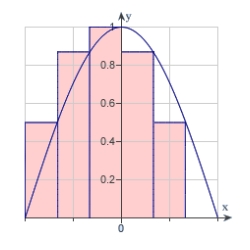
A) 3.9082
B) 2.6055
C) 1.9541
D) 1.4656
E) 0.9770
 .
. 
A) 3.9082
B) 2.6055
C) 1.9541
D) 1.4656
E) 0.9770
1.9541
4
Decide whether the following problem can be solved using precalculus, or whether calculus is required. If the problem can be solved using precalculus, solve it. If the problem seems to require calculus, use a graphical or numerical approach to estimate the solution. Find the distance traveled in 20 seconds by an object moving with a velocity of  feet per second.
feet per second.
A) calculus, 162.4485 ft
B) precalculus, 163.7985 ft
C) calculus, 165.4777 ft
D) precalculus, 165.4777 ft
E) precalculus, 162.4485 ft
 feet per second.
feet per second.A) calculus, 162.4485 ft
B) precalculus, 163.7985 ft
C) calculus, 165.4777 ft
D) precalculus, 165.4777 ft
E) precalculus, 162.4485 ft

فتح الحزمة
افتح القفل للوصول البطاقات البالغ عددها 10 في هذه المجموعة.
فتح الحزمة
k this deck
5
Use the rectangles in the graph given below to approximate the area of the region bounded by  Round your answer to three decimal places.
Round your answer to three decimal places. 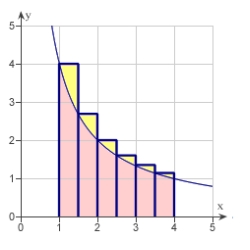
A) 2.481 units2
B) 6.371 units2
C) 3.585 units2
D) 6.872 units2
E) 6.903 units2
 Round your answer to three decimal places.
Round your answer to three decimal places. 
A) 2.481 units2
B) 6.371 units2
C) 3.585 units2
D) 6.872 units2
E) 6.903 units2

فتح الحزمة
افتح القفل للوصول البطاقات البالغ عددها 10 في هذه المجموعة.
فتح الحزمة
k this deck
6
Decide whether the following problem can be solved using precalculus, or whether calculus is required. If the problem can be solved using precalculus, solve it. If the problem seems to require calculus, use a graphical or numerical approach to estimate the solution. Find the area of the shaded region bounded by the triangle with vertices (0,0), (8,9), (17,0). 
A) precalculus , 153
B) calculus , 229.5
C) precalculus , 76.5
D) precalculus , 229.5
E) calculus , 153

A) precalculus , 153
B) calculus , 229.5
C) precalculus , 76.5
D) precalculus , 229.5
E) calculus , 153

فتح الحزمة
افتح القفل للوصول البطاقات البالغ عددها 10 في هذه المجموعة.
فتح الحزمة
k this deck
7
Consider the length of the graph of  Approximate the length of the curve by finding the sum of the lengths of four line segments, as shown in following figure. Round your answer to two decimal places.
Approximate the length of the curve by finding the sum of the lengths of four line segments, as shown in following figure. Round your answer to two decimal places. 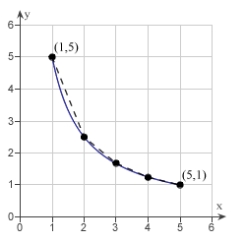
A) 6.11
B) 8.12
C) 5.66
D) 8.49
E) 7.11
 Approximate the length of the curve by finding the sum of the lengths of four line segments, as shown in following figure. Round your answer to two decimal places.
Approximate the length of the curve by finding the sum of the lengths of four line segments, as shown in following figure. Round your answer to two decimal places. 
A) 6.11
B) 8.12
C) 5.66
D) 8.49
E) 7.11

فتح الحزمة
افتح القفل للوصول البطاقات البالغ عددها 10 في هذه المجموعة.
فتح الحزمة
k this deck
8
Decide whether the following problem can be solved using precalculus, or whether calculus is required. If the problem can be solved using precalculus, solve it. If the problem seems to require calculus, use a graphical or numerical approach to estimate the solution. Find the area of the shaded region. 
A) calculus , 11
B) precalculus , 11
C) precalculus , 13
D) calculus , 16
E) precalculus , 16

A) calculus , 11
B) precalculus , 11
C) precalculus , 13
D) calculus , 16
E) precalculus , 16

فتح الحزمة
افتح القفل للوصول البطاقات البالغ عددها 10 في هذه المجموعة.
فتح الحزمة
k this deck
9
Use the rectangles in the following graph to approximate the area of the region bounded by  .
. 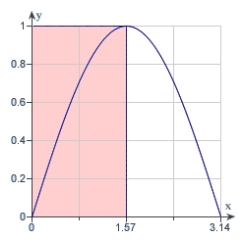
A) 0.7850
B) 1.5700
C) 3.1400
D) 1.1775
E) 1.0519
 .
. 
A) 0.7850
B) 1.5700
C) 3.1400
D) 1.1775
E) 1.0519

فتح الحزمة
افتح القفل للوصول البطاقات البالغ عددها 10 في هذه المجموعة.
فتح الحزمة
k this deck
10
Decide whether the following problem can be solved using precalculus, or whether calculus is required. If the problem can be solved using precalculus, solve it. If the problem seems to require calculus, use a graphical or numerical approach to estimate the solution. A cyclist is riding on a path whose elevation is modeled by the function  where x and
where x and  are measured in miles. Find the rate of change of elevation when x = 4.
are measured in miles. Find the rate of change of elevation when x = 4. 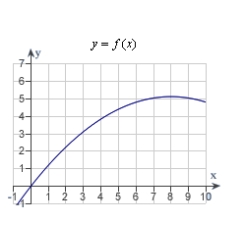
A) precalculus, 0.08
B) calculus, 0.2
C) calculus, 0.64
D) calculus, 0.08
E) precalculus, 0.2
 where x and
where x and  are measured in miles. Find the rate of change of elevation when x = 4.
are measured in miles. Find the rate of change of elevation when x = 4. 
A) precalculus, 0.08
B) calculus, 0.2
C) calculus, 0.64
D) calculus, 0.08
E) precalculus, 0.2

فتح الحزمة
افتح القفل للوصول البطاقات البالغ عددها 10 في هذه المجموعة.
فتح الحزمة
k this deck








